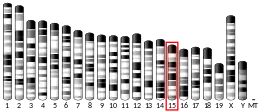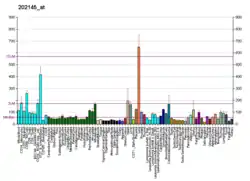LY6E
Lymphocyte antigen 6E is a protein that in humans is encoded by the LY6E gene.[5][6][7] Increased expression of Ly6E is associated with poor survival outcome in multiple malignancies as determined by a survey of more than 130 published clinical studies of gene expression studies on cancer tissue samples and adjacent normal tissues.[8] Ly6E is associated with drug resistance and tumor immune escape in breast cancer.[9] Further research is required to validate Ly6E for translation research.
| LY6E | |||||||||||||||||||||||||||||||||||||||||||||||||||
|---|---|---|---|---|---|---|---|---|---|---|---|---|---|---|---|---|---|---|---|---|---|---|---|---|---|---|---|---|---|---|---|---|---|---|---|---|---|---|---|---|---|---|---|---|---|---|---|---|---|---|---|
| Identifiers | |||||||||||||||||||||||||||||||||||||||||||||||||||
| Aliases | LY6E, RIG-E, RIGE, SCA-2, SCA2, TSA-1, lymphocyte antigen 6 complex, locus E, lymphocyte antigen 6 family member E | ||||||||||||||||||||||||||||||||||||||||||||||||||
| External IDs | OMIM: 601384 MGI: 106651 HomoloGene: 56411 GeneCards: LY6E | ||||||||||||||||||||||||||||||||||||||||||||||||||
| |||||||||||||||||||||||||||||||||||||||||||||||||||
| |||||||||||||||||||||||||||||||||||||||||||||||||||
| |||||||||||||||||||||||||||||||||||||||||||||||||||
| |||||||||||||||||||||||||||||||||||||||||||||||||||
| |||||||||||||||||||||||||||||||||||||||||||||||||||
| Wikidata | |||||||||||||||||||||||||||||||||||||||||||||||||||
| |||||||||||||||||||||||||||||||||||||||||||||||||||
References
- ENSG00000160932 GRCh38: Ensembl release 89: ENSG00000278032, ENSG00000160932 - Ensembl, May 2017
- GRCm38: Ensembl release 89: ENSMUSG00000022587 - Ensembl, May 2017
- "Human PubMed Reference:". National Center for Biotechnology Information, U.S. National Library of Medicine.
- "Mouse PubMed Reference:". National Center for Biotechnology Information, U.S. National Library of Medicine.
- Capone MC, Gorman DM, Ching EP, Zlotnik A (Sep 1996). "Identification through bioinformatics of cDNAs encoding human thymic shared Ag-1/stem cell Ag-2. A new member of the human Ly-6 family". J Immunol. 157 (3): 969–73. PMID 8757598.
- Mao M, Yu M, Tong JH, Ye J, Zhu J, Huang QH, Fu G, Yu L, Zhao SY, Waxman S, Lanotte M, Wang ZY, Tan JZ, Chan SJ, Chen Z (Jul 1996). "RIG-E, a human homolog of the murine Ly-6 family, is induced by retinoic acid during the differentiation of acute promyelocytic leukemia cell". Proc Natl Acad Sci U S A. 93 (12): 5910–4. doi:10.1073/pnas.93.12.5910. PMC 39161. PMID 8650192.
- "Entrez Gene: LY6E lymphocyte antigen 6 complex, locus E".
- Luo, Linlin; McGarvey, Peter; Madhavan, Subha; Kumar, Rakesh; Gusev, Yuriy; Upadhyay, Geeta (2016-02-03). "Distinct lymphocyte antigens 6 (Ly6) family members Ly6D, Ly6E, Ly6K and Ly6H drive tumorigenesis and clinical outcome". Oncotarget. 7 (10): 11165–93. doi:10.18632/oncotarget.7163. ISSN 1949-2553. PMC 4905465. PMID 26862846.
- Hossiny, Midrar A.; Luo, Linlin; Frazier, William R.; Steiner, Noriko; Gusev, Yuriy; Kallakury, Bhaskar; Glasgow, Eric; Creswell, Karen; Madhavan, Subha; Kumar, Rakesh; Upadhyay, Geeta (2016-04-11). "Ly6E/K signaling to TGF-β promotes breast cancer progression, immune escape and drug resistance". Cancer Research. 76 (11): 3376–3386. doi:10.1158/0008-5472.CAN-15-2654. ISSN 0008-5472. PMC 4910623. PMID 27197181.
Further reading
- Maruyama K, Sugano S (1994). "Oligo-capping: a simple method to replace the cap structure of eukaryotic mRNAs with oligoribonucleotides". Gene. 138 (1–2): 171–4. doi:10.1016/0378-1119(94)90802-8. PMID 8125298.
- Brakenhoff RH, van Dijk M, Rood-Knippels EM, Snow GB (1997). "A gain of novel tissue specificity in the human Ly-6 gene E48". J. Immunol. 159 (10): 4879–86. PMID 9366413.
- Suzuki Y, Yoshitomo-Nakagawa K, Maruyama K, Suyama A, Sugano S (1997). "Construction and characterization of a full length-enriched and a 5'-end-enriched cDNA library". Gene. 200 (1–2): 149–56. doi:10.1016/S0378-1119(97)00411-3. PMID 9373149.
- Shan X, Bourdeau A, Rhoton A, Wells DE, Cohen EH, Landgraf BE, Palfree RG (1998). "Characterization and mapping to human chromosome 8q24.3 of Ly-6-related gene 9804 encoding an apparent homologue of mouse TSA-1". J. Immunol. 160 (1): 197–208. PMID 9551972.
- Kosugi A, Saitoh S, Noda S, Miyake K, Yamashita Y, Kimoto M, Ogata M, Hamaoka T (1998). "Physical and functional association between thymic shared antigen-1/stem cell antigen-2 and the T cell receptor complex". J. Biol. Chem. 273 (20): 12301–6. doi:10.1074/jbc.273.20.12301. PMID 9575182.
- Ding L, Shevach EM (2001). "Inhibition of the function of the FcγRIIB by a monoclonal antibody to thymic shared antigen-1, a Ly-6 family antigen". Immunology. 104 (1): 28–36. doi:10.1046/j.1365-2567.2001.01275.x. PMC 1783287. PMID 11576217.
- Zammit DJ, Berzins SP, Gill JW, Randle-Barrett ES, Barnett L, Koentgen F, Lambert GW, Harvey RP, Boyd RL, Classon BJ (2002). "Essential Role for the Lymphostromal Plasma Membrane Ly-6 Superfamily Molecule Thymic Shared Antigen 1 in Development of the Embryonic Adrenal Gland". Mol. Cell. Biol. 22 (3): 946–52. doi:10.1128/MCB.22.3.946-952.2002. PMC 133557. PMID 11784869.
- de Nooij-van Dalen AG, van Dongen GA, Smeets SJ, Nieuwenhuis EJ, Stigter-van Walsum M, Snow GB, Brakenhoff RH (2003). "Characterization of the human Ly-6 antigens, the newly annotated member Ly-6K included, as molecular markers for head-and-neck squamous cell carcinoma". Int. J. Cancer. 103 (6): 768–74. doi:10.1002/ijc.10903. PMID 12516096. S2CID 42182637.
This article is issued from Wikipedia. The text is licensed under Creative Commons - Attribution - Sharealike. Additional terms may apply for the media files.




